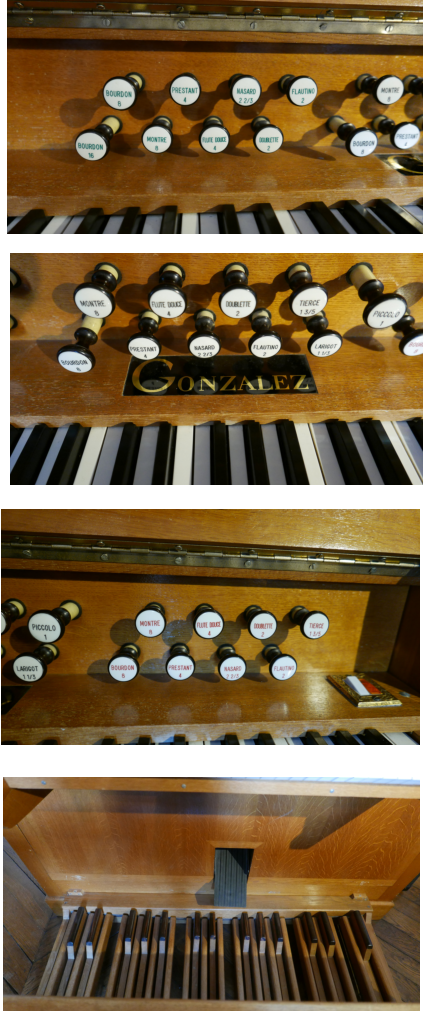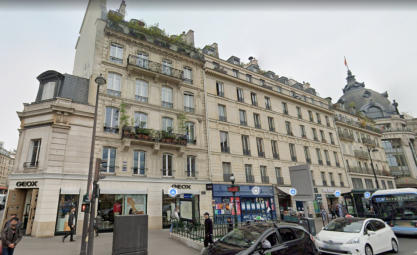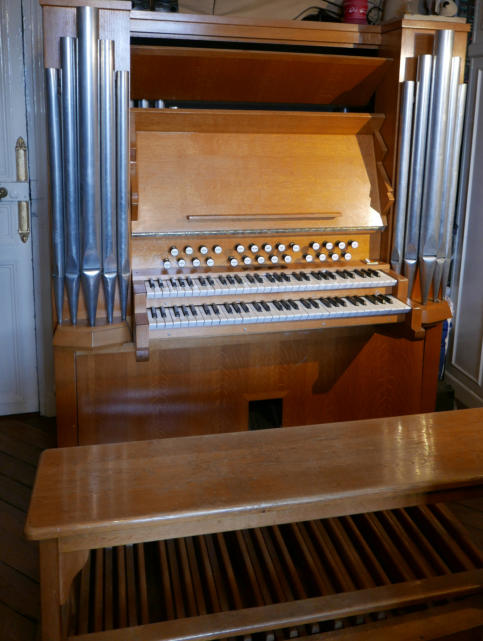


ORGANS OF PARIS © 2024 Vincent Hildebrandt HOME ALL ORGANS
Apartment of
Jean Galard



D1
Jean Galard, titular organist of Beauvais Cathedral
and Saint-Médard Church in Paris owns a special
salon organ, made by Gonzalez in the second half
of the 20th century.
Gonzalez named this organ model "Unit Baby"
because of the "Unit" system that manages the
pipes. This was the system used for cinema
organs, almost a century ago. Each pipe rests on
the wind chest that supplies it with the wind
independently. Indeed, under each pipe, there is
a valve whose opening is controlled by an
electromagnet.
So it's all a question of electrical management:
each key on the keyboard operates as many
contacts as the keyboard contains stops
("needles" at the end of each key); then the
electricity (30V DC) passes through a set of
contacts corresponding to the selected stop
("jaw"). When you pull a stop, a larger
electromagnet slightly moves the 61 needles of
the jaw of this stop to make contact and the
current then arrives under the desired pipe of the
stop you have chosen, to operate its valve. There
are a lot of electrical wires inside! The current
models of the firm's successors no longer use
these jaws, but diodes that play the same role.
The two stops (bourdon 8' and prestant 4') were
not called "stops" but "series". Both sets have the
extra pipes to speak to the top of the keyboard
(36 more pipes up to the last note of the 1', and
31 of the prestant until the last note of the 1 1/3).
This organ has about the number of pipes of an
instrument of three stops.
Thanks to Jean Galard for this information.
Vidéo
196x - Victor Gonzalez
II/26 (3)


Organs of Paris
Apartment of
Jean Galard
ORGANS OF PARIS © 2024 Vincent Hildebrandt ALL ORGANS
D1
Jean Galard, titular organist of Beauvais Cathedral and
Saint-Médard Church in Paris owns a special salon
organ, made by Gonzalez in the second half of the
20th century.
Gonzalez named this organ model "Unit Baby"
because of the "Unit" system that manages the pipes.
This was the system used for cinema organs, almost a
century ago. Each pipe rests on the wind chest that
supplies it with the wind independently. Indeed, under
each pipe, there is a valve whose opening is controlled
by an electromagnet.
So it's all a question of electrical management: each
key on the keyboard operates as many contacts as the
keyboard contains stops ("needles" at the end of each
key); then the electricity (30V DC) passes through a set
of contacts corresponding to the selected stop ("jaw").
When you pull a stop, a larger electromagnet slightly
moves the 61 needles of the jaw of this stop to make
contact and the current then arrives under the desired
pipe of the stop you have chosen, to operate its valve.
There are a lot of electrical wires inside! The current
models of the firm's successors no longer use these
jaws, but diodes that play the same role.
The two stops (bourdon 8' and prestant 4') were not
called "stops" but "series". Both sets have the extra
pipes to speak to the top of the keyboard (36 more
pipes up to the last note of the 1', and 31 of the
prestant until the last note of the 1 1/3). This organ has
about the number of pipes of an instrument of three
stops.
Thanks to Jean Galard for this information.
Vidéo

196x - Victor Gonzalez





















